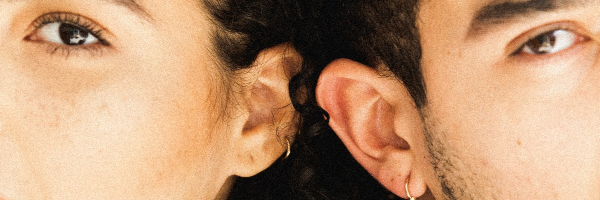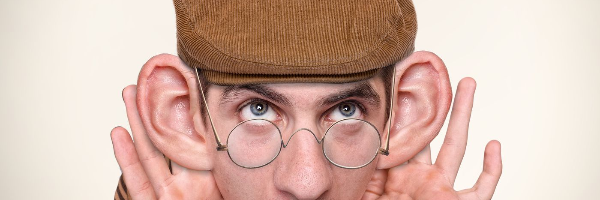Ears come in many different shapes and sizes, some are small, some are large, some stick out and others are thin.
Whatever the shape or size of the ear they are still worth studying from a body language point of view. Listen up! The ears do way more than we know and in ways you never thought.
Body Language Ears Table Of Contents
Understand Context First
The first thing we need to think about when studying body language is the context around why we want to understand what the other person is thinking or feeling.
Context can give us more clues, more ideas, and a better understanding of the person or people we are analyzing. So what is context?
From a body language point of view, context is the key to understanding what is really going on with the person we are observing.
Context is useful for figuring out what someone’s behavior means. This is because the behavior will mean different things in different settings. For example, a quick arm movement may indicate panic, but it could also be used to adjust one’s clothing – so we need to take context into account when interpreting body language
What Are The Objectives To Understand Body Language Of The Ears

The ears are a great indicator of where a person is focusing their attention, what they are interested in, and even what they want to hear. They may be telling you something without knowing it.
It is important to understand the body language of the ears because if you know what someone’s ears are saying, then you can better understand them as a person.
This section will talk about some ways that people use their ears to communicate with others.
What Are The Benefits Of Body Language

Body language is the nonverbal communication of emotions and attitudes of an individual. It can come in many forms, such as facial expressions, eye contact, gestures, touch, and posture.
Body language is one of the most powerful forms of nonverbal communication. It’s a form of communication that doesn’t need words to relay messages.
There are many benefits to body language- it can tell us if someone is happy or sad, confident or insecure. It can also provide insight into what someone is thinking or feeling without them having to say anything at all.
What Are The Different Types Of Body Language
There are many different types of body language. Gestures can be done with the hands or feet; facial expressions can include frowning or smiling; posture includes sitting up straight or slouching in a chair; eye contact is when someone looks at you in the eyes.
We will take a deep dive into body language of the ears in this article.
Who Is Typically Good At Picking Up On Body Language

According to research, the ability to pick up on body language is usually more common among women than men. This may be because women are more likely to have been socialized in the past to pay attention to others’ feelings and needs.
The best body language expert to ever live was a man called Milton Erickson, who had Polio from an early age and was paralyzed from the neck down. The only thing Milton could do was observe people and their moods.
How Can I Improve My Ability To Read People’s Body Language
Reading people’s body language is a skill that takes time and experience to master. The more you practice it, the better you will get at it. It is not as difficult as it may seem.
You can learn how to read people’s body language by observing what they do and how they move. You can also use your intuition and imagination to make educated guesses about their emotions and thoughts, but this is not always reliable. There is a full course we recommend that can be found on udemy.
Body Part
EAR’S
Where Are The Ear’s Located
The ears are located at the side of the head.
How Can I Use Body Lanague To Understand The Ears
You can tell if someone is embarrassed or guilty by noticing their ears or they could be simply cold or warm you have to pay attention to the context of the room also.
You can also tilt your head to the side if you want them to know you’re listening, in other words, let them know you’re interested in what they’re saying.
What are the advantages of using this tool
When you notice a person’s ears change color, this is a strong indication that they are experiencing an emotional shift.
This can be used to your advantage by thinking about what the conversation is about and what questions were asked before the ears changed color.
What Are The Benefits Of Noticing Body Language Of The Ears
The main advantage of noticing the ears’ shift in color is that it’s an automatic response. In other words, we can’t control or regulate when the ears change color.
Understanding The Ear Shapes

The ear is a sensitive organ that can reveal a lot about a person’s mood and personality. Although this hasn’t been proven scientifically it’s worth mentioning here as I do think the shape of the ears matter.
Some of the most common shapes of ears are:
- Lop Eared: This kind of ear can appear as if it is dropping towards the ground. They are usually large and floppy. These people will have a quiet introverted personality, but they will also have an artistic streak.
- Rounded Ears: This type of ear will be rounded from the front and then taper to a point at the back. These people often have an outgoing personality with a strong connection to their sense of creativity or humor or both.
- Pointy Ears: This type of ear will start wide from the front and then taper to a sharp point at the back – these people usually have an outgoing personality with a lot of energy.
- Larger ears that point out: These people are turned away from the head and stick out almost – they are great listeners and are good at picking up on sounds in their surroundings.
Body Language Of The Ears
Touching The Ears
We won’t go into detail here as I felt this topic on-ear touching needed more expansion. If you would like to learn more check Touching The Ear, A Better Understanding.
Ear Rings

Various modifications can be made to the ears including decorations, piercings, coloring, plugs, and more. These changes often align with the cultural norms of a region or ethnicity.
Ornamentation of the ear is, generally, specific to a culture and serves to communicate someone’s social status or level of availability for dating. It often tells us very accurate information about the person’s history, occupation, and personality.
Red Ears Or Ear Blushing

A great way to tell what someone is feeling is by looking at their ears. The skin on an ear may also flush when experiencing anger, embarrassment, or anxiety.
The skin will turn pink or red. The skin might also feel hot to the touch. Most people don’t have control over this, but some may make a person blush by mentioning it. The best way to handle this is to ignore them and move on.
The Listening Ear

A common way to communicate that you’re listening is by tilting your head towards someone to show you are listening. If you tilt your head and show your ear slightly, this lets the other person know that you have the intention of listening deeply.
Showing the ear while listening really helps to build rapport and a connection with a person. If you’re meeting a person for the first time, try this out.
Chinese Face Reading And The Ears

Face reading is an ancient Chinese art that is practiced to tell the fortune of a person, from childhood to future events.
In another word, it can reveal a lot about a person from childhood to future events.
The ears in Chinese face reading can also be used for a lot of information about a person. This is because the shape and size of the ears often reflect what kind of personality they have, how they behave, and what kind of life they will have.
I mention this here as it is a good topic to understand whilst studying body language the ears are a great source of information for Chinese face reading.
Video
Summary
There are many different non-verbal cues when it comes to understanding the body language of the ears. Research has shown that people can use the position and movement of the ear to determine how a person might be feeling.
For example, if someone is leaning in and their ear is angled towards you, they might be interested in what you have to say. If someone’s ears are pointed away from you and they are not making eye contact, it could mean that they do not want to talk to you or that they are frustrated with a conversation.

